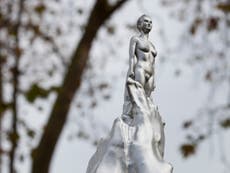Why aren’t there enough statues of women?
Mary Wollstonecraft is now honoured with a sculpture, but four-fifths of Britain’s statues are still of men, writes Maya Oppenheim


Your support helps us to tell the story
From reproductive rights to climate change to Big Tech, The Independent is on the ground when the story is developing. Whether it's investigating the financials of Elon Musk's pro-Trump PAC or producing our latest documentary, 'The A Word', which shines a light on the American women fighting for reproductive rights, we know how important it is to parse out the facts from the messaging.
At such a critical moment in US history, we need reporters on the ground. Your donation allows us to keep sending journalists to speak to both sides of the story.
The Independent is trusted by Americans across the entire political spectrum. And unlike many other quality news outlets, we choose not to lock Americans out of our reporting and analysis with paywalls. We believe quality journalism should be available to everyone, paid for by those who can afford it.
Your support makes all the difference.Mary Wollstonecraft has just been immortalised in in London but the same cannot be said for many other trailblazing women throughout history. Men make up the overwhelming majority of the statues in Britain’s streets and public squares, while women remain few and far between.
The new statue of Wollstonecraft, a writer who has been christened the ‘mother of feminism’, is set to be officially unveiled in Newington Green, on the border between Hackney and Islington, on Tuesday night.
Designed by sculptor Maggi Hambling and installed after a decade-long campaign, it shines a light on the question of why there are so few public memorials to women.
In 2018, the BBC calculated that 174 of 828 statues recorded by the Public Monuments and Sculpture Association were female — roughly one in five. And only 80 were named after women, in comparison to 422 of the male statues.
Bee Rowlett, who has chaired the campaign for Wollstonecraft's statue for six years, told The Independent that Black Lives Matter protests, which saw demonstrators topple a statue of 17th-century slave trader Edward Colston in Bristol, have changed the way statues are viewed.
Ms Rowlett, who has written a book about Wollstonecraft, said: “It changed the way people viewed statues and that is a good thing. It made us question who gets to be celebrated and who gets to live forever. There is currently a lack of statues of women which isn’t good.”
She noted Wollstonecraft was “actively annihilated in the press and the public mind” after she died - noting the feminist writer was subjected to “horrendous public ridicule”.
Ms Rowlett added: “She was explicitly trolled for not months but years in the public domain. Her legacy became toxic for best part of a century. That is why she is not more famous.”
Hitting back at criticism directed at the artwork for its nudity, she emphasised the fact that the statue was not intended to depict the feminist author and was an abstract work.
She said: “The mistake that people have made today is to confuse this artwork with a statue of Mary Wollenstonecraft. But it is not a statue of Mary Wollstonecraft. It is a sculpture for Mary Wollstonecraft. It is a celebration of her ideas. That is why it is abstract. That is why it is an everywoman figure.”
A statue of suffragist leader Millicent Fawcett was unveiled in Parliament Square in central London to commemorate 100 years of women’s suffrage back in 2018. The piece of artwork was the first ever female monument to be erected in Parliament Square - with Gillian Wearing being the first female sculptor to have shown their work there.
Sam Smethers, chief executive of leading gender equality charity, the Fawcett Society, told The Independent “honouring” Wollstonecraft was “long overdue”.
She added: “It has taken a team of volunteers to make this happen. We need many more statues of women all over the UK."
While Sarah Williamson, a senior lecturer at the University of Huddersfield who created a project called Art Activist Barbie to challenge women’s representation in the art world, told The Independent it was “disappointing to see yet another female nude statue be added to all the other female nude statues in London”.
She added: “And there are certainly plenty - you can hardly move for nude and semi-nude females languorously draping themselves all over the capital. On plinths, on buildings, in squares, roads and public places. What message does it send when we add to that in 2020? It’s even more disappointing when the statue is to commemorate the great Mary Wollstonecraft.
“I can’t think of many ‘great men’ who have been commemorated by a male nude statue in such a way. No, the males are nearly always fully dressed from head to toe. And sometimes they are literally in ‘fancy dress’ to emphasise their power and prestige – cast as mythological leaders, Roman emperors, gladiators etc. I can’t help but wish that Mary, regarded as the founder of feminism, had been commemorated differently – you know, by a statue with some clothes on.”
Jacqui Hunt, of Equality Now, noted statues and monuments mirror a society’s values by commemorating those who are thought to be “culturally or historically significant”.
She added: “The majority of statues currently are not reflective of an inclusive country of diverse heritage and contribution. Throughout history, women, people of colour, and other disadvantaged minorities have routinely been overlooked and their contributions to society ignored, downgraded or otherwise marginalised.
“It is important to have statues that celebrate women and normalise their achievements in a public manner so that representations of women in positions of power are displayed for all to see and acknowledge and for girls to know that they can be anything they aspire to be.
“However, a statue cannot be merely a tokenistic gesture or hollow substitute for tangible advancements in gender equality. This includes recognising women’s abilities and achievements alongside true equality in areas such as career progression, equal pay, shared childcare and other forms of support so that all women and girls can reach their full potential.”



Join our commenting forum
Join thought-provoking conversations, follow other Independent readers and see their replies
Comments